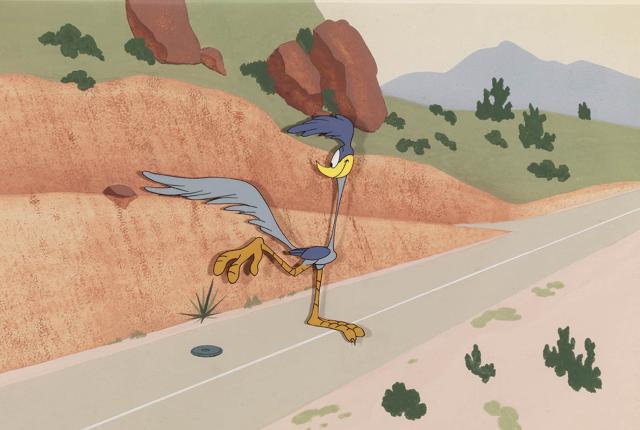Above: A new exhibit at the New Mexico Museum of Natural History & Science, in Albuquerque explores the world of Warner Bros. cartoons. Photograph courtesy of The New Mexico Museum Of Natural History & Science, © Warner Bros., Inc.
WHEN BUGS BUNNY missed that left turn at “Albakoiky,” he cemented a rather silly-sounding destination into the heads of millions of kids glued to Saturday morning cartoons. The Art of Warner Bros. Cartoons, a special exhibition at the New Mexico Museum of Natural History & Science, in Albuquerque, details the creation of Bugs, Wile E. Coyote, and the Road Runner and explores their comedic connections to New Mexico and the Southwest.
“I grew up on the East Coast, and I wouldn’t even have known Albuquerque existed if it weren’t for Bugs Bunny,” says museum director Margie Marino, who booked the playful show through January 2 to give people a “mental health break” over the holidays.
Besides engaging cartoon-loving kids, it will surely stoke nostalgia for grown-ups who remember watching the hapless Wile E. and his roadrunner nemesis race through the desert. The exhibit will include a reel showing all the references to New Mexico in Warner Bros. cartoons.
“When you look at the landscapes, the desert, and the mountains, these were unusual environments to people who weren’t even used to New Mexico being a part of the United States,” says Marino.
The exhibition draws on a collection of original drawings from the 1930s to the 1950s, the glory days of the Looney Tunes and Merrie Melodies era of Warner Bros. cartoons. That includes extremely delicate drawings on tissue paper, cel animations, and other materials that chronicle the process that led to such indelible characters.
“We see these cartoonists’ creative process, and they were brilliant in many ways,” Marino says. “The images appealed to kids, but the humor and wit was very adultlike. That is why families really enjoy Warner Bros. cartoons together.”
Here’s more fun: The museum will show cartoons on Saturday mornings, just like in the old days. Only this time, the cartoons will be on the five-story Lockheed Martin DynaTheater screen. Educational programs will tear apart myths and misconceptions about women, Native Americans, and other groups found in the cartoons, and delve into the higher-level thinking required to bring them to life.
“There’s some really interesting math and science that goes into stop action and cel animation,” Marino says.
 The exhibition draws on a collection of original drawings from the 1930s to the 1950s. Photographs courtesy of The New Mexico Museum Of Natural History & Science, © Warner Bros., Inc.
The exhibition draws on a collection of original drawings from the 1930s to the 1950s. Photographs courtesy of The New Mexico Museum Of Natural History & Science, © Warner Bros., Inc.
Toon vs. Truth
But what if the coyote had a rocket-powered anvil?
News flash! Roadrunners never say “meep meep” (males coo, like doves). How else do coyotes and roadrunners differ from their Warner Bros. counterparts? We asked Laurel Ladwig, a master naturalist with Bernalillo County Open Space and director of the Backyard Refuge Program for the Friends of Valle de Oro National Wildlife Refuge.
Would a coyote eat a roadrunner? Nope; too pointy. “Roadrunners have very sharp beaks and toes. It’s theoretically possible. But I’ve seen a lot of coyote poop, and I’ve never seen any feathers.”
Who’s faster? Roadrunners top out at about 20 miles per hour, while coyotes can hit 40 miles per hour. “Roadrunners have this perception of being fast because they have such quick acceleration.”
Who’s smarter? Toss a coin. “They are both survivors. Roadrunners are spreading all over the cities. And coyotes are really good at being around us without causing too much fuss.”

Museum of Natural History & Science, 1801 Mountain Road NW, Albuquerque; 505-841-2800.


